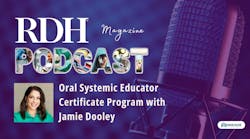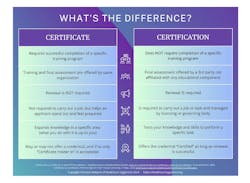6 differences between a certificate program and a certification
It’s such an exciting time to be a dental hygienist! We’re blessed with many career pathways in public and community health outreach, media and communications, management and administration, and health care and medicine. We are finally valued for our knowledge, intellect, and leadership skills.
With new career options comes training programs, but how do you choose the right one for you based on your career growth goals? The first item to consider is the difference between a certificate and a certification for training. Global standards have been set for training programs for decades, but since the online education boom, any individual or organization can offer a training program and advertise it without following any standards.
When I founded the National Network of Healthcare Hygienists (NNHH) in 2018, the original board felt it was imperative to achieve a higher level of quality and consumer safety in our training programs than were available for hygienists at the time. We met AGD PACE standards but wondered if there were standards for individual programs as well. (ADG PACE only approves organizations; they do not accredit individual programs.)
Our programs involve dental/medical integration and collaboration, so we knew that to be taken seriously by the health-care industry we needed a mark of excellence above and beyond traditional dental CE. Hospitals value accreditation and require individual programs to be accredited for nurses. So, we looked at RN certifications and university-level certificate programs and modeled our first program after theirs.
What is accreditation?
Accreditation is a voluntary process through which a third-party organization grants recognition to an organization, system, or program after verifying that it has met minimum criteria and demonstrated compliance to written performance standards through an application and onsite review process.1
The difference between an accredited program and approved dental CE
Both AGD PACE and ADA CERP approve organizations that offer education, not individual programs themselves. Many dental providers think the AGD PACE or ADA CERP logos mean a program has been accredited. But according to both of their written standards, the terms “accredited,” “accreditation,” or “certification” must not be used in conjunction with approval. Also, providers must not make statements implying approval or endorsement of individual courses.2,3
The AADH uses the term "accreditation" in their continuing education standard, however, their standards are nearly identical to AGD and ADA, as stated on their website.4 Unfortunately, there are programs claiming to be accredited when they really just offer CE through an approved provider and no specific training program standards have been met or audited by a third party via an onsite review. Additionally, a training program cannot award a certificate of attendance or participation, which is the most common type of certificate in dental CE. A training program requires proof of proficiency.
Training program standards and accreditors
There are two main global standards for training programs:
- Certificate program ASTM E2659-19 certificate accreditation programs
- Certification program ISO/IEC 17024 personnel credentialing organizations
Organizations involved with professional certification and accreditation include American National Standards Institute (ANSI), the Center for Association Leadership (ASAE), ASTM International, Association of Test Publishers (ATP), International Accreditation Forum (IAF), and Institute for Credentialing Excellence (ICE).1
An important fact to consider when choosing an accreditation body is who is accrediting them. You can typically find that information on the About Us page. After years of research, we chose ANSI National Accreditation Board (ANAB) because they are the largest multidisciplinary accreditation body in the western hemisphere with more than 3,000 organizations accredited in approximately 80 countries.5
No one in dentistry was following ANAB standards for training programs at the time, but the American Dental Association was using ANAB to set other standards, including dental tools and products, informatics, and electronic records.6 This was enough for us to trust them as the third-party accreditor of our training programs.
Like most training programs in dental hygiene, our program had elements of both a certificate and a certification. To protect consumers (students) and avoid conflicts of interest, the same organization cannot educate and assess (test) for a certification. Since we manage both the curriculum and the final assessment of our program, we chose certificate program ASTM E2659-19.
Let’s review the key differences so that you will be empowered to ask good questions and choose the best program for you.7,8
Besides these basic standards, there were items we’d never heard of that were required for both standards. We had to carry out an item and form analysis, conduct a passing score study, tighten up our systems and processes, and more. Two long years and 168 standards later, our program was finally on par with what dental hygienists deserve for advanced education—excellence.
The Oral Systemic Educator (OSE) program became the first certificate program in dentistry in the world to achieve ANSI accreditation! There were so many times when we almost withdrew our application because the process was so time consuming and expensive. We had to hire consultants to help us cross the finish line, and it was worth it.
I share our story to inspire students and program developers to not fear failure, but instead embrace it as an opportunity for growth. With each noncompliance ticket we received, we were able to improve our program. Since ANSI is not dental-specific and is globally recognized, stakeholders outside dentistry and the US have already started to accept the program. ANSI accreditation is a stamp of excellence.
We hope our achievement inspires the leaders of other programs to apply for accreditation so that more hygienists can have a globally recognized, third option between regular dental CE and a degree. We can blaze new trails faster and easier than ever before, sharing knowledge and experiences with each other without going back to school. We must challenge ourselves and each other to think innovatively and keep growing, individually and collectively. And we must collaborate and support each other along the way.
References
1. Rops MS. Certification simplified: A primer for staff and volunteer leaders. ASAE. 2011.
2. AGD PACE program guidelines. Revised March 2024. Accessed August 15, 2024. https://www.agd.org/docs/default-source/pace/pace-guidelines-march-2024.pdf
3. ADA CERP recognition standards and procedures. May 2024. Accessed August 15, 2024. https://ccepr.ada.org/-/media/project/ada-organization/ada/ccepr/files/cerp_standards.pdf
4. AADH standards of quality continuing education. Accessed August 15, 2024. https://form.jotform.com/ofAmerican/ce-provider-application--american-a
5. ANSI National Accreditation Board. ANAB. November 18, 2024. https://anab.ansi.org/
6. Victor A. Understanding American national standards for dental practices. The ANSI Blog. August 18, 2023. https://blog.ansi.org/american-national-standards-for-dental-practices/
7. Certification vs. certificate in ANAB-CFP accreditation. ANSI National Accreditation Board. November 20, 2024. https://anab.ansi.org/certification-vs-certificate-in-anab-cfp-accreditation/
8. Certificate vs. certification: which is right for you? Husson University. September 14, 2023. https://www.husson.edu/online/blog/2023/09/certificate-vs-certification









